ââ‹during the Mycenaean Period Largescale Figural Art on the Greek Mainland Was
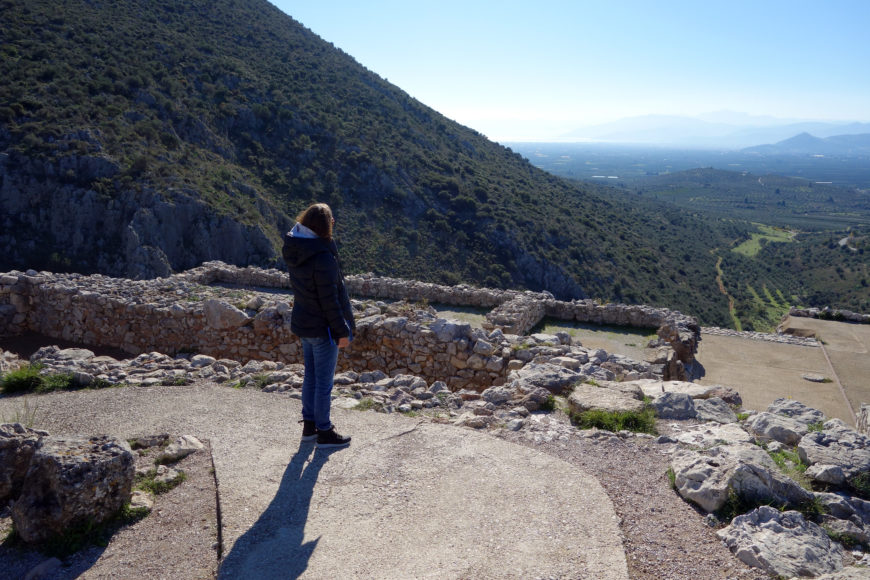
Looking past the "Palace" to the bounding main, Mycenae, Hellenic republic, c. 1600–1100 B.C.E.
The ancient citadel (fortified city) at Mycenae is located on top of an isolated colina and provides truly spectacular views of the surrounding surface area, making information technology an platonic location for a defensive stronghold. Mycenaean civilisation dominated southern Greece, but is perhaps best known for the site of Mycenae itself, which includes the citadel (with a palace), and is surrounded by different forms of tombs and other structures. Mycenaean culture firmly establishes itself in the late Bronze Historic period, specifically, around 1600 B.C.E.
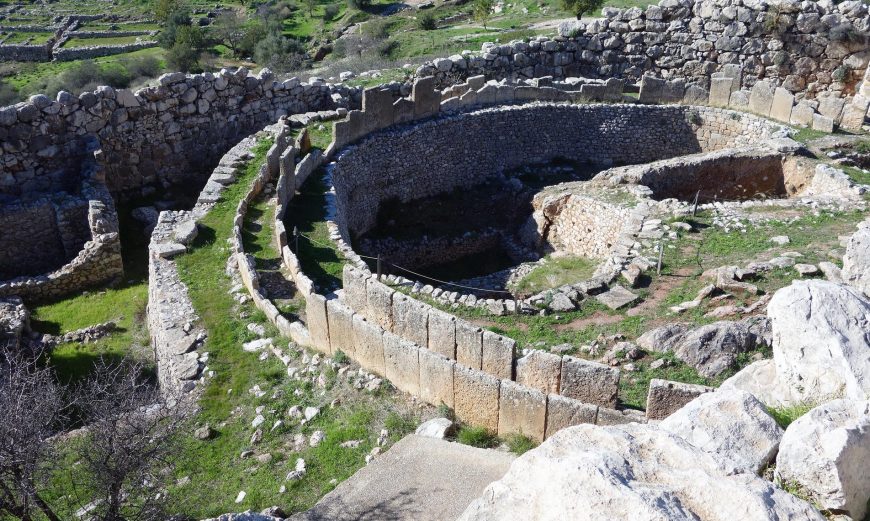
The "Palace" and Grave Circle A, Mycenae, c. 1600–1100 B.C.E.
At around 1600 B.C.East.—seemingly out of nowhere—the shaft graves at the site of Mycenae are built. These are two circular walled plots containing graves, built some 50 years autonomously, shut to the fortification wall of the citadel. Archaeologists named these "Grave Circle A" and "Grave Circle B." Grave Circle B is earlier than A (but A was discovered offset) and contained some 14 shaft graves with 24 burials; Grave Circumvolve A held half-dozen shaft graves with 19 burials. These burials contained men, women, and children who were related to one another, recent Deoxyribonucleic acid analysis has shown.

Mask of Agamemnon, from shaft grave V, Grave Circle A, Mycenae c.1550–1500 B.C.E., gilded, 12″ / 35 cm (National Archaeological Museum, Athens)
More importantly, along with the burials one of the largest deposits of precious metals, specially gold (including the Mask of Agamemnon), ever institute in aboriginal Hellenic republic was discovered. An even wealthier single shaft grave has been recently discovered near the Mycenaean palace at Pylos. The wealth of the shaft graves is shocking, a huge modify from the before rather small-scale remains of Bronze Age mainland Greece, and initiates an era of Mycenaean activity and ability which stretches beyond most of the region.
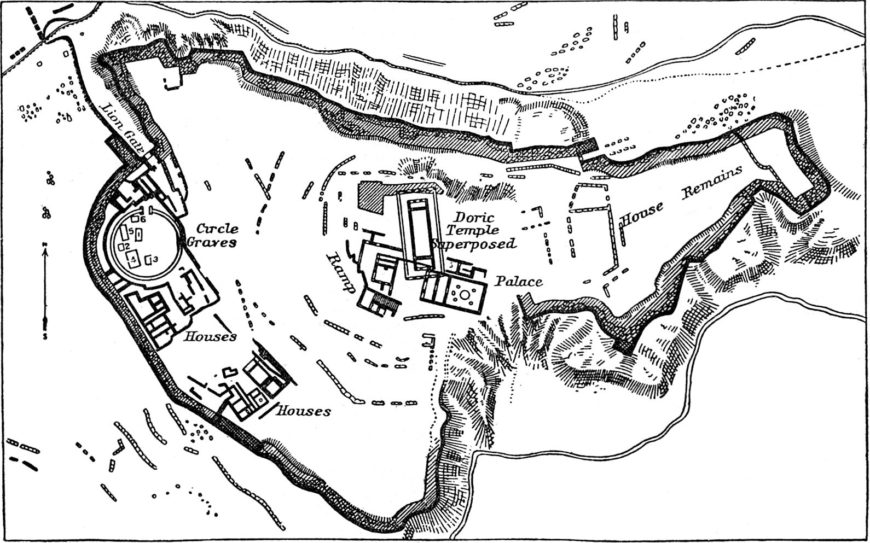
Plan of the Citadel of Mycenae
The focus sites of this era are Mycenaean palaces which all have several aspects in common: a primal megaron or throne room with a large hearth which is adjacent to an open court, commanding views of an agricultural plane, colorful and oft figural wall painting, and associations with grand burial structures such as tholoi (beehive tombs). These types of sites can be found not only at Mycenae but also at Tiryns, Iolkos, Orchomenos, Gla, Pylos, Thebes, and on the acropolis at Athens.
Written and visual records
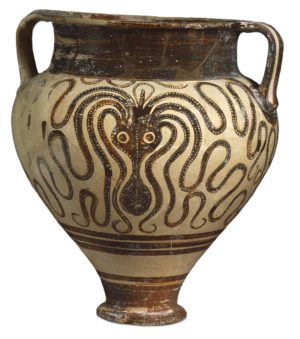
Pictorial Way bowl (krater), Mycenaean, c. 1375 B.C.East., 41 cm high (The British Museum)
We know a lot about the Mycenaeans because they left written records which can be read. They wrote in a script called Linear B (related to the early Minoan Linear A) which recorded an early on form of the Classical Greek language. At the sites of Mycenae, Pylos, Tiryns, and Thebes clay tablets inscribed in Linear B have been plant describing a theocratic administration, very similar to the 1 described in the Linear B tablets plant at Knossos on Crete. A Wanax (the central figure of authority in Mycenaean society) presided over a complex religious and economic arrangement which, at Pylos, was centered around a perfume oil and material industry.
At that time at that place was regular contact and commutation between Mycenaean aristocracy and the Pharaonic court in Egypt. Stirrup jars, the uniquely branded vessels of the wildly successful Mycenaean perfume oil merchandise, are establish all over the Mediterranean bowl. The design and ornamentation of Mycenaean pottery riffs off older Minoan styles in almost modernist abstractions and produces the first narrative pottery painting tradition in the aboriginal Greek world.
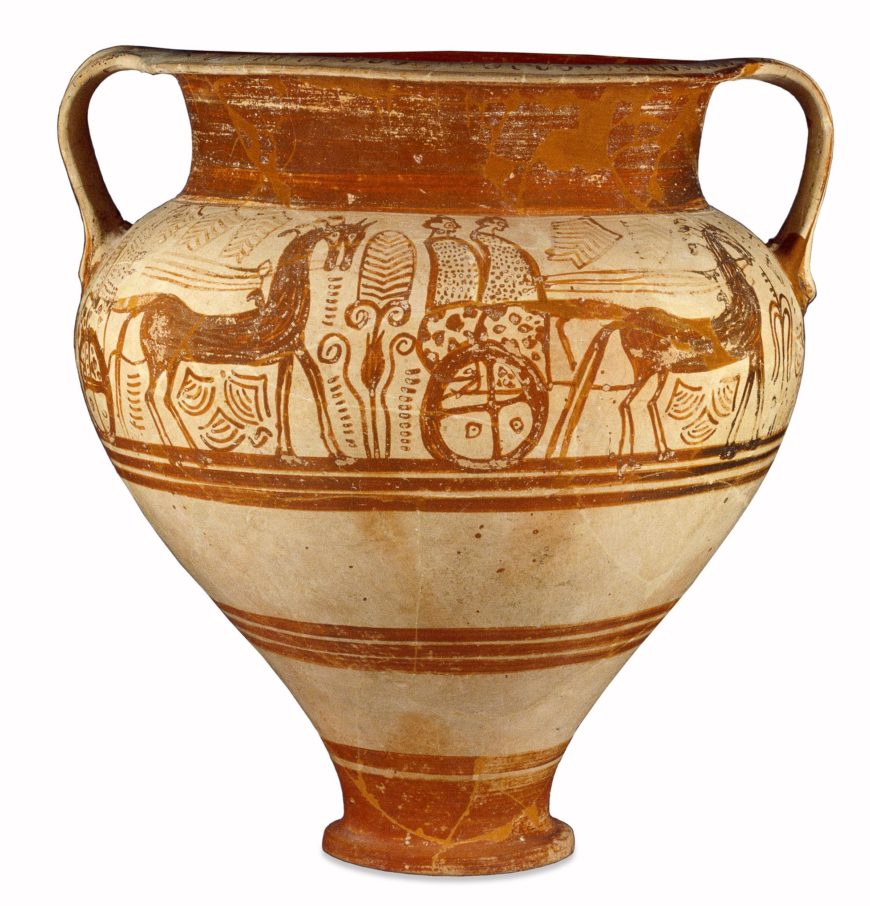
Amphoroid krater, Mycenaean, 1375–1300 B.C.E., 32 cm in diameter (The British Museum)
The motif of armed combat, manus-to-hand (parry and thrust), was perfected by Mycenaean artists, and tin be seen beautifully represented in the infinitesimal scale of gem engraving .
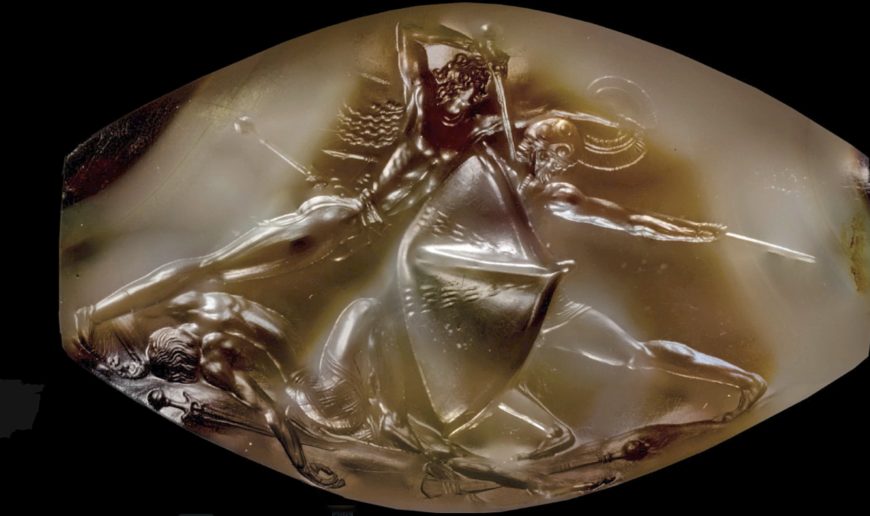
Two warriors in hand-to-hand combat, Pylos Gainsay Agate, discovered in the Grave of the Griffin Warrior at Pylos, c. 1450 B.C.E., ane.5 inches broad
At the aforementioned time, Mycenaean architects and engineers embraced a massive scale with huge hydraulic projects, far-flung road works, and defensive walls so gigantic they never succumb to burial, remaining largely intact and providing the inspiration for mythological explication until the modernistic era.
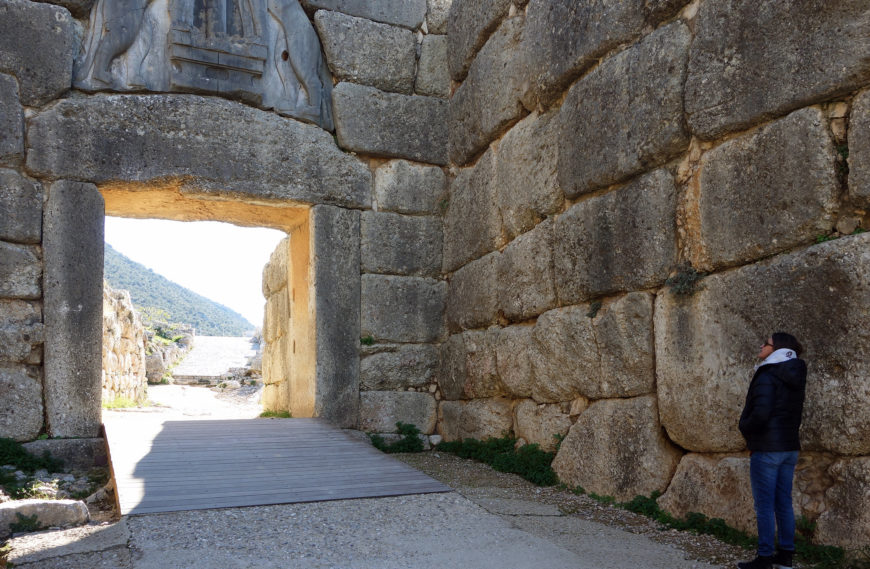 The "Palace" and Grave Circle A, Mycenae, c. 1600–1100 B.C.E. At effectually 1600 B.C.Due east.—seemingly out of nowhere—the shaft graves at the site of Mycenae are built. These are two circular walled plots of graves, built some l years apart, shut to the fortification wall of the citadel. Archaeologists named these "Grave Circle A" and "Grave Circumvolve B." Grave Circle B is earlier than A (only A was discovered first) and contained some 14 shaft graves with 24 burials; Grave Circle A held six shaft graves with 19 burials. These burials contained men, women and children, which contempo DNA analysis has shown were related to one some other.
The "Palace" and Grave Circle A, Mycenae, c. 1600–1100 B.C.E. At effectually 1600 B.C.Due east.—seemingly out of nowhere—the shaft graves at the site of Mycenae are built. These are two circular walled plots of graves, built some l years apart, shut to the fortification wall of the citadel. Archaeologists named these "Grave Circle A" and "Grave Circumvolve B." Grave Circle B is earlier than A (only A was discovered first) and contained some 14 shaft graves with 24 burials; Grave Circle A held six shaft graves with 19 burials. These burials contained men, women and children, which contempo DNA analysis has shown were related to one some other. Mask of Agamemnon, from shaft grave V, grave circle A, Mycenae c.1550-1500 B.C.East., gold, 12″ / 35 cm (National Archaeological Museum, Athens) More than importantly, forth with the burials was discovered one of the largest deposits of precious metals, specially gold (including the "Mask of Agamemnon"), ever plant in ancient Greece. An even wealthier unmarried shaft grave has been recently discovered near the Mycenaean palace at Pylos. The wealth of the shaft graves is shocking, a huge change from the earlier rather modest remains of Bronze Age mainland Hellenic republic and initiates an era of Mycenaean activity and power which stretches across most of the region. The focus sites of this era are Mycenaean palaces which all have several aspects in mutual: a key megaron or throne room with a large hearth which is adjacent to an open courtroom, commanding views of an agricultural aeroplane, colorful often figural wall painting, and associations with 1000 burying structures such equally tholoi. These types of sites tin be plant not but at Mycenae simply Tiryns, Iolkos, Orchomenos, Gla, Pylos, Thebes, and on the acropolis at Athens.
Written and visual records
Arroyo to the Lion Gate, Mycenae, c. 1300–1250 B.C.Eastward.
Around 1200 B.C.Eastward. nearly all major Mycenaean sites experienced massive destruction, the cause of which is unclear. Many sites were rapidly reinhabited, but the elite areas, such as the spaces where information technology is believed the Wanax ruled, were not rebuilt. For the side by side 50 to 75 years, pottery production and even wall painting continues simply becomes less fine and increasingly regional, eventually ceasing all together. Burial practice changes as well, from shaft graves to small individual cist graves (small below-ground stone boxes) containing cremated remains.
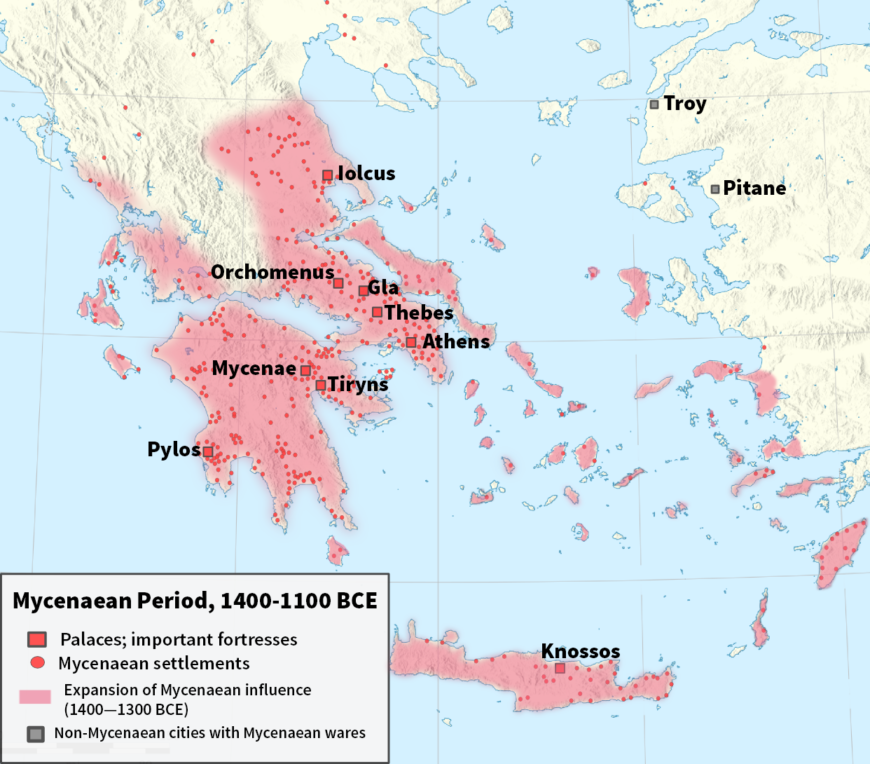
Map of Mycenaean Greece 1400–1200 B.C.E. Palaces, main cities and other settlements.
By 1050 B.C.E., at the end of the Bronze Age, the Greek globe (the Cycladic islands, Crete, and the Mainland), have only memories left of the once wealthy and far reaching polities which had ruled for nigh a millennium, an era presently to be beautifully enshrined in the oral epic tradition of Homer.
Additional resources
Mycenaean culture on the Metropolitan Museum of Art's Heilbrunn Timeline of Art History
Archaeological Sites of Mycenae and Tiryns (UNESCO)
Grave of the Griffin Warrior, Pylos Greece
Sharon R. Stocker, and Jack L. Davis. "The Combat Agate from the Grave of the Griffin Warrior at Pylos." Hesperia: The Journal of the American School of Classical Studies at Athens, vol 86, no. 4 (2017), pp. 583-605
Source: https://smarthistory.org/intro-mycenaean-art/
0 Response to "ââ‹during the Mycenaean Period Largescale Figural Art on the Greek Mainland Was"
Post a Comment